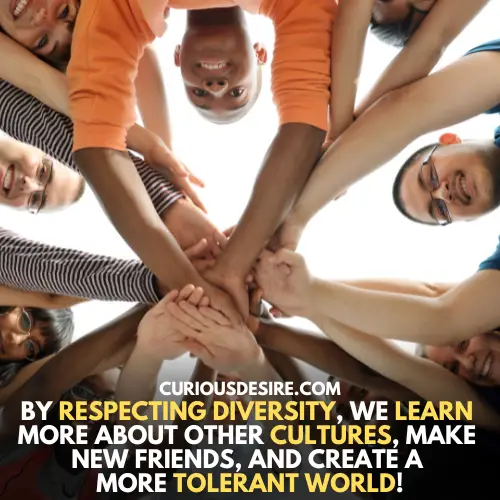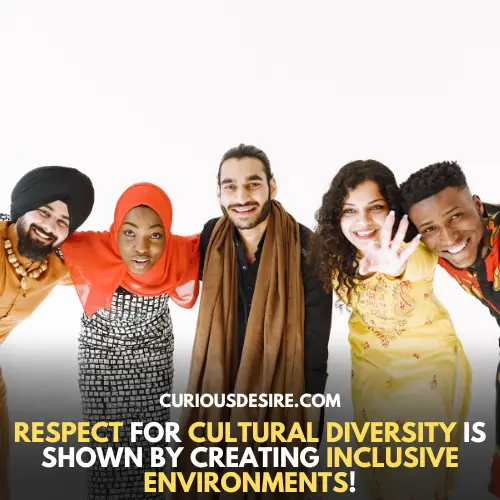Diversity is one of the most important aspects of our world. It is what makes us unique and interesting, and it should be celebrated. Respect for diversity means understanding and valuing the differences between people, cultures, religions, races, etc. It means accepting everyone for who they are, and not judging them based on their differences.
When we respect diversity, we open our minds to new possibilities and learn more about the world around us. We also create a more tolerant society in which everyone can feel safe and accepted. So why is respect for diversity so important? Read on to find out.
What is Meant by Respect for Diversity?
Respect for diversity is about valuing the differences between people. It means accepting others for who they are, and not judging them based on their race, religion, culture, or any other difference. When we respect diversity, we create a more tolerant world in which everyone can feel safe and accepted.
Why is it Important to Respect Diversity?
There are many reasons why respect for diversity is so important. By respecting diversity, we:
- Learn more about other cultures and ways of life.
- Make new friends and build strong relationships.
- Create a more tolerant world in which everyone can feel safe and accepted.
- Show our children the importance of tolerance and understanding.
How Do You Promote Respect for Diversity?
There are many ways to promote respect for diversity. Here are some things you can do:
- Be open-minded and willing to learn about other cultures
- Make an effort to meet people from different backgrounds
- Respect other people’s beliefs and values
- Avoid making assumptions or judgments about others
- Stand up against discrimination and bigotry
- Celebrate the differences between people
Respecting diversity is important because it allows us to learn more about other cultures, make new friends, create a more tolerant world, and show our children the importance of tolerance and understanding.
There are many ways we can respect diversity, and it starts with being open-minded and willing to learn about other cultures. Let’s all make an effort to respect diversity and create a more tolerant world for everyone.
Setting 1 – Respect for Diversity in the Workplace
The workplace is one of the most important places to respect diversity. By doing so, you create a more inclusive environment where everyone can feel safe and respected. You also set a positive example for your colleagues and employees.
All employees should feel respected in the workplace, regardless of their race, gender, religion, or sexual orientation. A respectful workplace is one where all employees feel valued and are treated fairly. A diverse workforce can bring a variety of perspectives and ideas to the workplace, which can lead to increased creativity and innovation.
Respecting diversity in the workplace can help to create a more positive and productive work environment for all employees.

How to Value Diversity in the Workplace
One of the best ways to show respect for diversity in the workplace is to value each employee’s individual talents and contributions. When everyone feels valued and appreciated, it creates a more positive and productive work environment.
Additionally, it’s important to be aware of and sensitive to the different cultural backgrounds and experiences of your employees. By understanding and respecting the differences among your employees, you can create a more inclusive workplace where everyone feels comfortable and respected.
It’s also important to avoid making assumptions or judgments about others based on their cultural background or appearance. Instead, take the time to get to know each person as an individual. This will help you to better understand and appreciate the unique perspectives that each person brings to the workplace.
Additionally, avoid using stereotypes or making generalizations about groups of people. Doing so can create an atmosphere of mistrust and disrespect.
In order to show respect for diversity in the workplace, it’s important to create an environment where everyone feels welcome and included. This can be done by ensuring that your workplace policies are fair and inclusive, providing training on diversity and inclusion for all employees, and encouraging open communication between employees of different backgrounds.
By creating a workplace that values diversity, you can show your employees that you respect and appreciate them for who they are.
How do you Show Respect for Diversity in the Workplace?
There are many ways you can show respect for diversity in the workplace. Here are some things you can do:
1. Listen
One of the best ways to show respect for diversity in the workplace is to simply listen. This means being open to hearing about and understanding the experiences of others, even if they are different from your own. It also means being willing to have difficult conversations about topics such as race, gender, and sexual orientation.
2. Be Inclusive
Another way to show respect for diversity in the workplace is to be inclusive. This means making an effort to create a work environment where everyone feels welcome, valued, and respected. This can be done in a number of ways, such as ensuring that there is a diverse range of employees represented in company policies and procedures, providing training on unconscious bias and cultural competence, and establishing employee resource groups for underrepresented groups.
3. Stand Up For Others
Standing up for others is another important way to show respect for diversity in the workplace. This means speaking out against discrimination, harassment, and other forms of mistreatment. It also means being an ally for those who are marginalized or underrepresented.
Why is it Important to Respect Diversity in the Workplace?
Respect for diversity in the workplace is important for a number of reasons. Here is the importance of respect for diversity:
1. Increased Productivity
When employees feel respected, they are more likely to be productive. A study by the Harvard Business Review found that employees who feel respected are more engaged with their work and are more likely to stay with their company. Additionally, employees who feel respected are more likely to have a positive attitude toward their company and its leadership.
2. Improved Communication
Respect for diversity can also improve communication between employees. When employees feel respected, they are more likely to feel comfortable communicating with those who are different from them. This can lead to a better exchange of ideas and a greater understanding of others’ perspectives.
3. Enhanced Creativity
A diverse workforce can also enhance creativity in the workplace. When employees feel comfortable expressing their unique perspectives, they are more likely to come up with creative solutions to problems. Additionally, a diverse workforce can provide a variety of perspectives that can help to spark new ideas.
4. Increased Job Satisfaction
Employees who feel respected at work are also more likely to be satisfied with their jobs. A study by the Society for Human Resource Management found that employees who feel respected are more satisfied with their jobs and are less likely to leave their company which can save an organization time and money in the long run. Additionally, employees who feel respected are more likely to recommend their company to others.
Setting 2 – Respect for Diversity in Social work
Social work is all about helping people in need and promoting social justice. As a social worker, it’s important to respect the diversity of your clients and their individual needs. By respecting diversity, you create a more inclusive environment where clients can feel safe and respected. You also set a positive example for other social workers.
Why is Diversity Important in Social Care?
Diversity is important in social care because it allows carers to better understand and meet the needs of their clients. When carers respect the diversity of their clients, they create a more inclusive environment where everyone can feel safe and respected. This also sets a positive example for other carers.
By respecting diversity, we learn more about other cultures, make new friends, create a more tolerant world, and show our children the importance of tolerance and understanding.

Diversity Issues in Social Work
There are a number of diversity issues that social workers need to be aware of, such as:
- Racial discrimination
- Ageism
- Sexism
- Ableism
- Homophobia
It’s important that social workers are aware of these issues so that they can better support their clients.
Setting 3 – Respect for Diversity in the Classroom
The classroom is a great place to start teaching children about respect for diversity. By promoting respect for diversity in the classroom, you can increase cooperation between students, reduce bullying, and create a more inclusive environment.
There are many ways to promote respect for diversity in the classroom, such as:
- Encouraging students to celebrate their differences
- Teaching students about different cultures and traditions
- Leading by example and treating everyone with respect
How do you Show Respect for Diversity in the Classroom?
By leading by example and treating everyone with respect, you can show your students the importance of respecting diversity. You can also encourage them to celebrate their differences and learn about different cultures and traditions. By promoting respect for diversity in the classroom, you can create a more inclusive environment for all.
Students should learn to respect diversity in many settings, including:
- The classroom
- The Workplace
- Social work
- The home
In this way, when they will be graduated they will be prepared to show respect for diversity in any setting.
Why Should Teachers Respect Diversity?
There are many reasons why teachers should respect diversity in the classroom, such as:
- It can help reduce bullying
- It can lead to increased cooperation between students
- It can create a more inclusive environment
When teachers respect diversity, they are setting a positive example for their students. By promoting respect for diversity in the classroom, teachers can help create a more tolerant world.
What are the Challenges of Diversity in the Classroom?
There are a number of challenges that teachers may face when trying to promote respect for diversity in the classroom, such as:
- Students who are resistant to change
- Lack of knowledge about other cultures
- Limited resources
Despite these challenges, it’s important that teachers continue to promote respect for diversity in the classroom. By doing so, they can help create a more inclusive environment for all students.
Setting 4 – How Do You Show Respect for Cultural Diversity? 5 Ways
There are many ways to show respect for cultural diversity, such as:
1. Learning About Other Cultures
It is important to learn about the customs and traditions of other cultures. This will help you to understand and respect the differences between them.
2. Treating Everyone With Respect
When you treat everyone with respect, you show that you value their culture and traditions.
3. Celebrating Difference
By celebrating the differences between cultures, you can show your respect for them. This can be done by learning about other cultures, sharing your own culture with others, and celebrating cultural events.
4. Avoiding Stereotypes
It is important to avoid stereotypes when you are trying to show respect for cultural diversity. Stereotypes are oversimplified and often inaccurate generalizations about a group of people.
5. Creating Inclusive Environments
One of the best ways to show respect for cultural diversity is to create inclusive environments. This can be done by ensuring that everyone feels welcome and respected in your workplace, school, or community.

How Can You Show Respect for Diversity in Communication?
There are a number of ways to show respect for diversity in communication, such as:
- Listening to others
- Using nonverbal communication
- Avoiding stereotypes
- Respecting personal space
When you are communicating with someone from a different culture, it is important to listen to them and respect their point of view. You should also avoid using stereotypes and respect personal space. By doing so, you can show your respect for their culture and traditions.
Conclusion
Respecting diversity is important in many settings, including the classroom, workplace, social work, and home. Respect for diversity can help reduce bullying, increase cooperation between people and create a more inclusive environment. In this way, the world can become a more tolerant place.